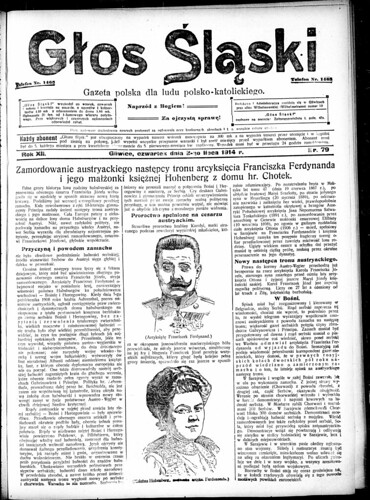This week one hundred years ago, on 28th of June 1914, Archduke Franz Ferdinand of Austria was assassinated. This event triggered the outbreak of WWI one month later. How did European newspapers of the time cover this crucial event and the political opinions? Did the news travel fast? Europeana Newspapers has gathered historic newspaper material to illustrate how different European newspapers reported on this crucial event. This week we’ll publish a series of three articles, each covering one important event in WWI. Today we start with the assassination of Archduke Franz Ferdinand of Austria.
On 28 June 1914 Archduke Franz-Ferdinand, heir to the Austro-Hungarian throne, and his wife, the Duchess of Hohenberg, were murdered in Sarajevo by the Serbian nationalist Gavrilo Princip. For about one century this dramatic event is known as the triggering event of World War One. Indeed, the exacerbation of nationalistic tensions in Central and Balkan Europe, an Austro-Hungarian declining monarchy and the play of strategic and diplomatic alliances precipitated within a month the European continent into war.
Yet what might be obvious today was not so much at that time and the announcement of this assassination in the newspapers of the time throughout Europe does not reflect or foresee the gravity of the situation.
When looking back on European newspapers of the time, two main common themes can be distinguished:
- A murder story full of twists
- A family tragedy
A murder story full of twists
No source allows us to know with certainty what happened. The trial minutes inform us nevertheless that a conspiracy took place. The seven conspirators had no experience in the use of weapons, and it is only by an extraordinary series of coincidences that they succeeded.
On the morning of 28 June 1914, the Archduke’s parade of six cars passed a first conspirator who tried to shoot from the window of an upper floor, but renounced as he could not get a clear shot. A second member did not attempt anything since he was fearful of harming the Duchess. A third member, Nedeljko Čabrinović, threw a bomb on the car of Archduke Franz Ferdinand, but in his haste, he did not wait the recommended eight seconds to throw it. It seems that the prince had time to take the bomb in his hand and to throw it out of his car. The explosion nevertheless destroyed the next car, seriously injuring its passengers, a policeman and several people in the crowd. Čabrinović tried to kill himself by swallowing a cyanide pill and jumping into the river Miljacka. As the cyanide pill he had taken was old or too low dosed and the tide of river was very low, he failed in his attempt and was arrested.
Later in the morning, the Archduke decided to go to the hospital to visit the victims of the bomb. Gavrilo Princip saw his car passing near Latin Bridge, caught it and fired twice. The first bullet pierced the side of the car and reached the Duchess of Hohenberg in the abdomen, the second bullet struck the Archduke in the neck. Both died of their wounds fifteen minutes later. Like Čabrinović, Princip attempted suicide and failed.
The Austrian newspapers were the first ones to cover the event, as to be expected. The Montags Journal reported Der Thronfolger von Österreich ermordet! Seine Gemahlin die Herzogin von Hohenberg ermordet! (The heir to the throne of Austria murdered! His wife the duchess of Hohenberg murdered!). On this day, 29th of June, an extra edition was printed in which the assassination of the heirs to the Austrian throne was extensively covered. In the days following other Austrian newspapers covered the assassination and the victims in all detail; such as Das Interessante Blatt (frontpage, page 3, page 5) and Wiener Bilder (frontpage and page 5).

The Bozner Zeitung of Monday 29 June 1914 featured the news on its frontpage on and covers it from page 1 to 5. Entitled Erzherzog Franz Ferdinand und Herzogin von Hohenberg ermordet (Archduke Franz Ferdinand and Duchess of Hohenberg murdered), the article conveys the course of the two attacks reporting on the happy ending of the first bomb assassination and the tumultuous ovation from the people that expressed the joy of the failed attempt. It also reports on the continuation of the journey, on the second, and this time successful, attack carried out. It gives details too on the assassin, the 19 years old Princip, who named the deed “revenge of the oppressed of Serbia”.
The attack is strongly condemned by the magazine and described as “one of the most dreadful prince-murders of late”.


Telegraph messages of the murder of Franz Ferdinand and his wife started arriving in the Netherlands on Monday 29 June 1914. Most newspapers include a small message somewhere in the paper on the murder. Like the Algemeen Handelsblad, in which a small message on the frontpage in the left column below is featured with the title De moord op het vorstenpaar (Murder on the royal couple).
The next day, on Tuesday 30 June, full reports have reached the country including detailed statements of the eyewitnesses, which are no doubt copied from local Bosnian papers. All newspapers open with the full story of the murder, like the Nieuwsblad van het Noorden.

On 1 July 1914, the Turkish newspapers Sabah also gives details of what is called a “tragedy” providing the murderers’ confession and details of the investigation: “…Except the two perpetrators arrested yesterday, other men are arrested. A joint movement is suspected ».
A family tragedy
Being a public figure by birth and because of his function as an Emperor, Franz Joseph also drew the attention of the media with his marriage to Duchess Elisabeth of Bavaria better known as Sissi. His family life had so far already been filled with several dramas. His first daughter Sophie died as an infant and his only son, Crown Prince Rudolf, died by suicide in 1889. His wife was stabbed to death by an Italian anarchist in 1898 while on a visit to Geneva. It is said that Franz Joseph never fully recovered from the loss.


In French newspapers, the event is covered as mondain/society news. Rare are the journalists who glimpsed the military outcome that would bring Europe into war. In less than four days, the news had left newspapers frontpage. For example, La Croix from 30 June 1914 focuses on the tragic destiny of the Austro-Hungarian Empire. The newspaper fears that this assassination will weaken the catholic monarchy with whom it hoped for reconciliation with France against the German Empire. La Croix pictures Emperor Franz Joseph as a martyr.
On 12 July 2014, Le Petit Journal puts on its frontpage an illustration of the Emperor grieving on his throne and surrounded by his deceased family members. The headline reads La tristesse du vieil empereur. Rien ne lui aura été épargné sur cette terre! (The sadness of the old emperor. He has been spared nothing on this Earth!).


The Polish newspaper Głos Śląski in its issue of 2 July 1914 tells the story of the spell put on Emperor Franz Josef by the Countess Karolyi.
The Bozner Zeitung of Friday 3 July 1914 reports on the popular outrage and solicitousness, and the great compassion for the Emperor who already suffered so many blows of fate. The images show The Konak in Sarajewo, the itinerary of the coffin and the manor house Artstetten, the last resting-place of Franz Ferdinand and his wife.
More historic newspaper coverage on the assassination of Archduke Franz Ferdinand and his wife Duchess of Hohenberg in our Flickr album.

Pingback: O atentatu u stranim novinama - 1914 1914
great stuff
good stuff
nice thanks helped me with school
Helped me with my essay… I definitely didn’t cheat and look it all up… jokes, jokes this was homework. I had to make a newspaper report on the death and how it caused WW1!!!
me too!!
me too. i swear these teachers just find these on some website somewhere and have us do them
I have to do a newspaper on this by three different perspectives
me too, oh my god you are so right
omg same though I’m trying to look for a decent headline anyone got any ideas ??
oh my god me three!
lmao me too!
lol me 2!!
i had the same task lmao
Me too!! @_@
Bro same!!
Pingback: ‘Causes or the First World War’, un ejemplo de cómo preparar una unidad didáctica usando AICLE | Los hilos de Clío
Pingback: CLIL instead of AICLE: going through the causes of the Great War once more | Los hilos de Clío
This is quality material for my American history class of students who, generally, have not much interest in anything. Hence, to make them think, or read is a challenge. However, this is exciting global reading for them and they should become engaged in the way news was portrayed at the time.
I am a Dutch citizen teaching in America and I find your web site very helpful for my students. My school is a school for moderate- to severe behaviour problem students, which might explain their lack of interest at times.
Gosh that’s a bit deep!?!
thanks helped alot with my school work
Why were they tensions between Austria Hungary and Bosnia at the time?
Bosnia had recently been given freedom from the Austria-Hungary empire. The Austria-Hungarians didn’t like this.
Also it is good to know that the Serbian parliament ordered the assassination to take place showing that the Serbs had tension with the Austria-Hungarians also.
The Serbs had Russia with them and because of the Alliance System, Britain and France were on the Serbs side too.
Also because of the Alliance System, Germany and Italy were with Austria-Hungary.
This turned a 2 nation war into an 8 nation war.
Please note that Bosnia weren’t in the war till much later as none of it was there fault.
This helps
g
i agree
thanks this helped me with my homework!!! 🙂
Hi everyone, it’s my first pay a quick visit at this web site, and piece of
writing is really fruitful in favor of me, keep up posting these types of
articles.
Helped me to do my homework
Pingback: We’re All Addicted to Bad News. Here’s How to Stop.
same reason im here
This is a inspiring piece
this helped to do my homework but at the same time there’s just so much knowledge you can get out of this. i’m 14 and i am quite grumpy but its really a good thing to learn about.